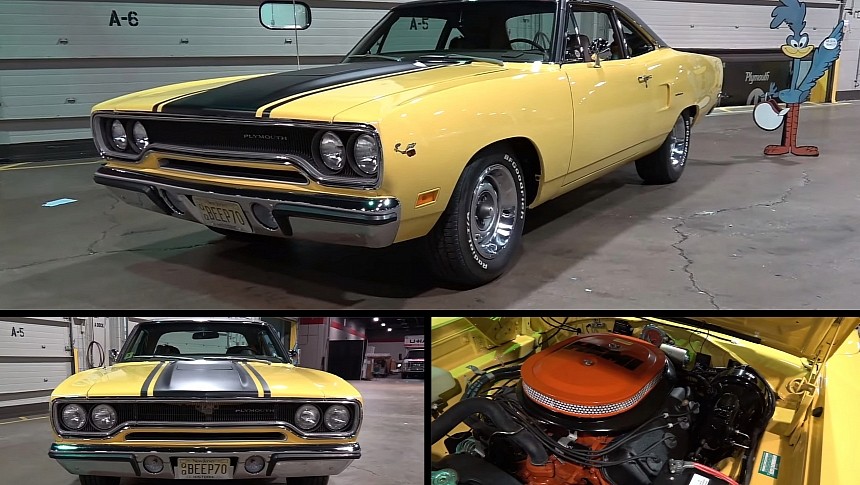Whenever I see a rusty classic in a junkyard, I think about how many decades it must have spent in that very spot. Because it takes a few good decades for a solid car to morph into a rust bucket. But that's not always the case. Some rigs need only a few years to become scrap metal on wheels.
The 1970 Plymouth Road Runner you see here is one of those cars that didn't take long to develop rust holes. Sure, it looks pretty good right now, but the owner shares the Mopar was quite awful back in 1979 when he bought it. In his own words, the car belonged in a junkyard, even though it was only nine years old at the time.
But he bought it anyway because it was dirt cheap, he was very young, and couldn't afford a proper car anyway. Years later, he decided to restore it, and here we are: the Road Runner is now a museum-grade classic that looks like it just left the assembly line.
"Spotless" is the best word to describe this Plymouth. The yellow paint is perfect, the black stripes are where they should be, and the chrome shines like new. The interior is just as gorgeous. And thankfully enough, it's not one of those dull all-black cabins. This one sports brown vinyl upholstery, making for a rare combo with the yellow exterior.
However, it's important to note that this Road Runner wasn't restored to its factory specs. The car wasn't born with bucket seats and a center console, and it didn't have a radio or air conditioning either. The owner wanted a nicer configuration and sourced all these parts from other Road Runners (there are plenty of them rotting away out there anyway).
But the most significant upgrade lurks in the sparkling clean engine bay. This Mopar rolled off the assembly line with a 383-cubic-inch (6.3-liter) big-block V8. The original mill was already gone when the owner got the car, so he opted for a 426-cubic-inch (7.0-liter) HEMI transplant. The mill looks as accurate as they get and mates to a four-speed manual transmission.
This combo is decidedly rare. Of the 36,861 Road Runners sold in 1970, only 152 units left the assembly line with the mighty HEMI mill. Just 74 were two-door post cars like this one, and only 44 had the four-speed manual gearbox.
Sure, it may seem pointless to list all these numbers when talking about a HEMI replica, but it's the kind of info you need to know to better understand why some people choose to build tribute vehicles. The 1970 HEMI Road Runner is a six-figure classic nowadays, and examples in pristine condition can go for more than $200,000.
The lack of authenticity doesn't bother me that much, to be honest, especially if the car in question is period-correct. This one is, and it looks better than many original HEMI Road Runners out there. It was good enough for the 2023 Muscle Car and Corvette National (MCACN), so it definitely deserves a closer look. Go ahead and check it out in the video below.
But he bought it anyway because it was dirt cheap, he was very young, and couldn't afford a proper car anyway. Years later, he decided to restore it, and here we are: the Road Runner is now a museum-grade classic that looks like it just left the assembly line.
"Spotless" is the best word to describe this Plymouth. The yellow paint is perfect, the black stripes are where they should be, and the chrome shines like new. The interior is just as gorgeous. And thankfully enough, it's not one of those dull all-black cabins. This one sports brown vinyl upholstery, making for a rare combo with the yellow exterior.
However, it's important to note that this Road Runner wasn't restored to its factory specs. The car wasn't born with bucket seats and a center console, and it didn't have a radio or air conditioning either. The owner wanted a nicer configuration and sourced all these parts from other Road Runners (there are plenty of them rotting away out there anyway).
But the most significant upgrade lurks in the sparkling clean engine bay. This Mopar rolled off the assembly line with a 383-cubic-inch (6.3-liter) big-block V8. The original mill was already gone when the owner got the car, so he opted for a 426-cubic-inch (7.0-liter) HEMI transplant. The mill looks as accurate as they get and mates to a four-speed manual transmission.
This combo is decidedly rare. Of the 36,861 Road Runners sold in 1970, only 152 units left the assembly line with the mighty HEMI mill. Just 74 were two-door post cars like this one, and only 44 had the four-speed manual gearbox.
Sure, it may seem pointless to list all these numbers when talking about a HEMI replica, but it's the kind of info you need to know to better understand why some people choose to build tribute vehicles. The 1970 HEMI Road Runner is a six-figure classic nowadays, and examples in pristine condition can go for more than $200,000.
The lack of authenticity doesn't bother me that much, to be honest, especially if the car in question is period-correct. This one is, and it looks better than many original HEMI Road Runners out there. It was good enough for the 2023 Muscle Car and Corvette National (MCACN), so it definitely deserves a closer look. Go ahead and check it out in the video below.










